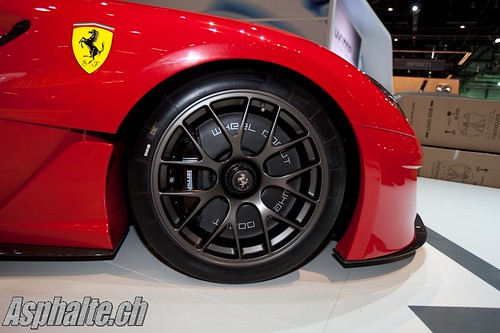
Good thing there is a financial crisis in the world. Ferrari invented the "hyper-track toy" car category with the FXX program. Sure Ferrari will tell you these non road legal and not race legal cars are really part of a development program and a rolling laboratory with customers acting as test drivers and testing innovative solutions for future road cars, we know they are just the thing to have if you want to win that coveted "Track Day World Championship" crown.
In any case, the program was such a success that after the FXX and the FXX Evoluzione, Ferrari found the market is there for a front engine FXX. We eagerly await a video of an FXX, a Zonda R and a 599FXX fighting in out in a "Formula Track Day" event soon!
To Ferrari's credit, this is clearly no ricer version of the 599. Powered by the same v12 as the FXX, slightly detuned to around a mere 800700hp, the 599XX sports sophisticated aerodynamics with bits reminiscent of all those now banned from Formula 1. The 599XX will also feature Ferrari's most advanced electronics, outside of F1, these systems will trickle down to the upcoming F430 replacement (codename f142). Some of the 599XX carbon fiber details might be offered as options on the 599 GTB sometime down the road.
More info is sure to come up in the near future, including why it appears to say "wheel donut" on the carbon brakes.....hmmmm donuts

full details and slideshow after the jump
While based on the 599 GTB Fiorano with the same transaxle layout and engine type, this prototype is an extreme track car. Ferrari's engineers have carried out extensive work on the engine's combustion chambers and inlet and exhaust tracts. These modifications, combined with the fact that internal attrition has been reduced and the maximum revs have been boosted to 9,000 rpm, helped achieve the target power output of 700 hp at 9,000 rpm. Particular attention was also paid to cutting the weight of the engine unit components. This was achieved both by optimising forms - as in the new crankshaft - and adopting exclusive materials, as in the carbon-fibre used for the intake plenums. A new gearbox shift strategy cuts overall gearchange times to 60 ms.
The 599XX is characterised by an innovative electronic concept called the "High Performance Dynamic Concept" which has been designed to get the maximum performance from the car by managing the combination of the car's mechanical limits with the potential of its electronic controls. The mechanical and electronic systems work together to get the maximum performance from the car under extreme high performance driving, for consistent lap times. The sporty handling has been improved thanks to the adoption of second generation SCM suspension system. Track usage is also made easier thanks to the new "virtual car engineer", a screen in the car that provides a real-time indication of the vehicle's efficiency.
The 599XX's aerodynamics were honed in numerous wind tunnel test sessions with the result that the car now boasts 280 kg of downforce at 200 km/h (630 kg at 300 km/h). The front underside of the body is completely faired-in and the vents that channel hot air from the engine bay have been moved to the bonnet.
The "ActiflowTM" system increases downforce and/or cuts drag depending on the car's trim cornering conditions, courtesy of the use of a porous material in the diffuser and two fans in the boot which channel the air flow from under the car out through two grilles next to the tail-lights. Winglets have been added to the rear buttresses to increase downforce. while synthetic jets have also been incorporated into the rear of the car to control and smooth the air flow and to reduce drag.
Ferrari's engineers have also used F1-derived "doughnuts" which partly cover the brake discs and wheel rim. These have the dual function of improving both aerodynamics and brake cooling.
In terms of the bodywork, composites and carbon-fibre have been widely used and the engineers drew on their experience in working with aluminium to reach the weight target. The development of increasingly high-performance materials has also benefited the carbon-ceramic material braking system. The brake pads are now made from carbon-fibre which means that the callipers are smaller whilst guaranteeing the same efficiency. The new racing carbon ceramic braking system also delivers shorter braking distances and is generally more efficient due to the weight saving.
The 599XX comes with slick tyres (29/67 R19 Front and 31/71 R19 Rear) specifically developed to maximise stability in cornering and increase lateral acceleration. They are fitted to 19 x 11J wheel rims at the front and 19 x 12J at the rear.

Dale E. just rolled over in his grave.
ReplyDelete(3)
-Freep
I wonder how all these cars compare to the Viper ACR and it's truck technology.
ReplyDelete@Fearless Freep - You took the words right out of my mouth. I was looking for the Lumina SS badging...
ReplyDeleteI suspect the "wheel donut" is a non-F1 variant of the brake-ducting hub-covers Ferrari has been using for the last several years. That said, "wheel donut" is an odd choice of nomenclature.
ReplyDeleteUpdate -- Ferrari is officially calling them "wheel donuts", and yes they serve the same purpose of aerodynamics and brake cooling efficiencies as the wheel covers on the F1 cars. Cool, but pity on the name.
ReplyDeleteWell, Homer Simpson will be happy!
ReplyDeleteIt would be interesting to know exactly HOW that works from INSIDE the wheel as opposed to on the edge of it and how the hot airflow from the brakes is directed.